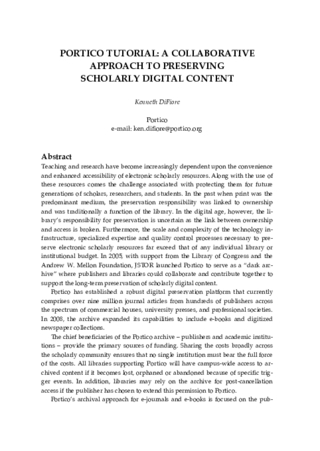Teaching and research have become increasingly dependent upon the convenience and enhanced accessibility of electronic scholarly resources. Along with the use of these resources comes the challenge associated with protecting them for future generations of scholars, researchers, and students. In the past when print was the predominant medium, the preservation responsibility was linked to ownership and was traditionally a function of the library. In the digital age, however, the library’s responsibility for preservation is uncertain as the link between ownership and access is broken. Furthermore, the scale and complexity of the technology infrastructure, specialized expertise and quality control processes necessary to preserve electronic scholarly resources far exceed that of any individual library or institutional budget. In 2005, with support from the Library of Congress and the Andrew W. Mellon Foundation, JSTOR launched Portico to serve as a “dark archive” where publishers and libraries could collaborate and contribute together to support the long-term preservation of scholarly digital content. Portico has established a robust digital preservation platform that currently comprises over nine million journal articles from hundreds of publishers across the spectrum of commercial houses, university presses, and professional societies. In 2008, the archive expanded its capabilities to include e-books and digitized newspaper collections. The chief beneficiaries of the Portico archive - publishers and academic institutions – provide the primary sources of funding. Sharing the costs broadly across the scholarly community ensures that no single institution must bear the full force of the costs. All libraries supporting Portico will have campus-wide access to archived content if it becomes lost, orphaned or abandoned because of specific trigger events. In addition, libraries may rely on the archive for post-cancellation access if the publisher has chosen to extend this permission to Portico. Portico's archival approach for e-journals and e-books is focused on the publishers’ source files – the electronic files containing graphics, text, or other material that comprise an electronic journal article, issue, or volume. Portico has chosen migration as its primary long-term archival approach, as part of a managed preservation strategy.This tutorial session will educate attendees about the factors driving libraries to an e-only environment and the growing concerns about the preservation of scholarly e-content. Also, the session will provide an in depth description of Portico’s business model and technological approach for providing a trusted archival home for e-scholarship and how its archive can assist scholarly publishing stakeholders in their transition from print to electronic. Specifically, attendees will learn:-the factors driving libraries and publishers toward the adoption of e-content;-the importance of digital preservation and the urgent need for action;-archival strategy trends within the community;-the significance of separating the access role from the preservation role;-the economies of scale and reduction of risk through broad cost sharing across the publisher and library community;-Portico’s economic model and preservation capabilities for e-content;-the trigger events and post-cancellation scenarios in which libraries access content from Portico, including a demonstration of the archive;-a description of Portico’s holdings comparison analysis and how it can be used to assist librarians with print collection management;-a comparison of how Portico and CLOCKSS addressed the recent trigger events.
DiFiore, Kenneth Andrew. "Portico Tutorial: A Collaborative Approach to Preserving Scholarly Digital Content." In Rethinking Electronic Publishing: Innovation in Communication Paradigms and Technologies - Proceedings of the 13th International Conference on Electronic Publishing, 27-28. ELPUB. Milano, Italy, 2009.
